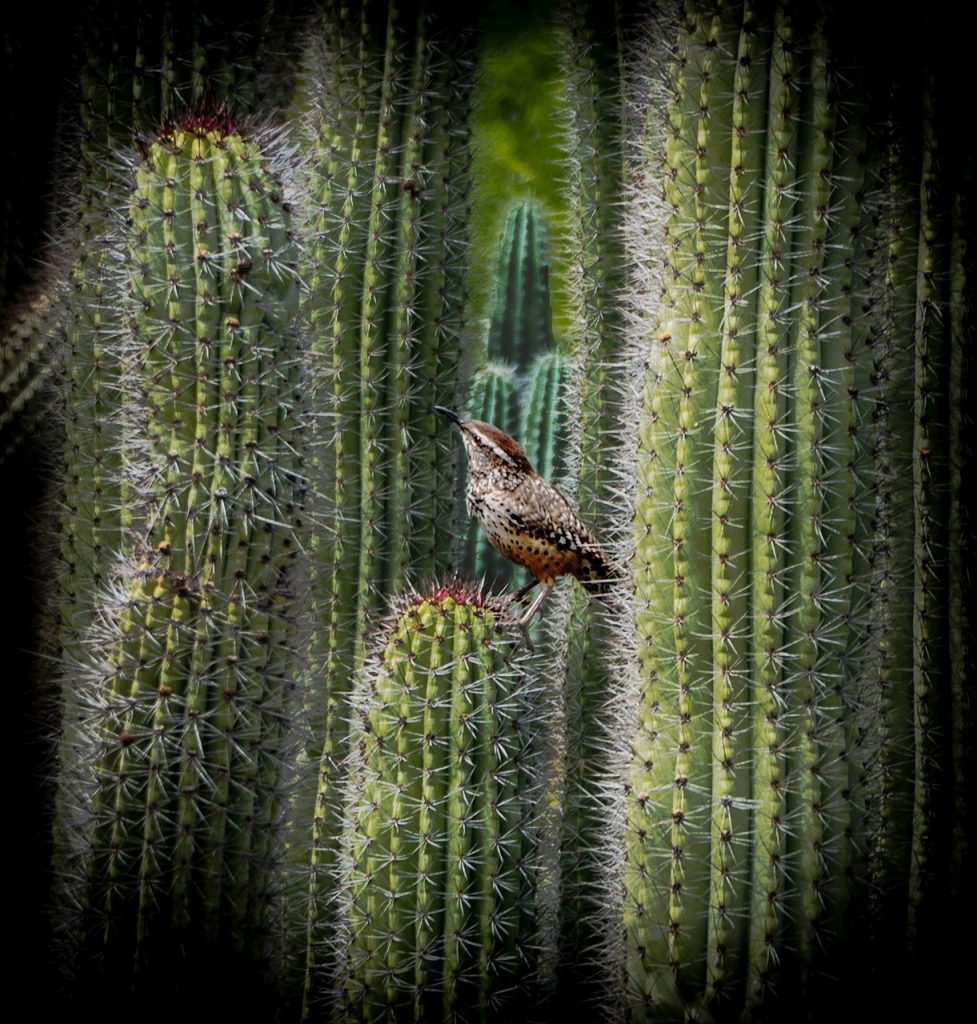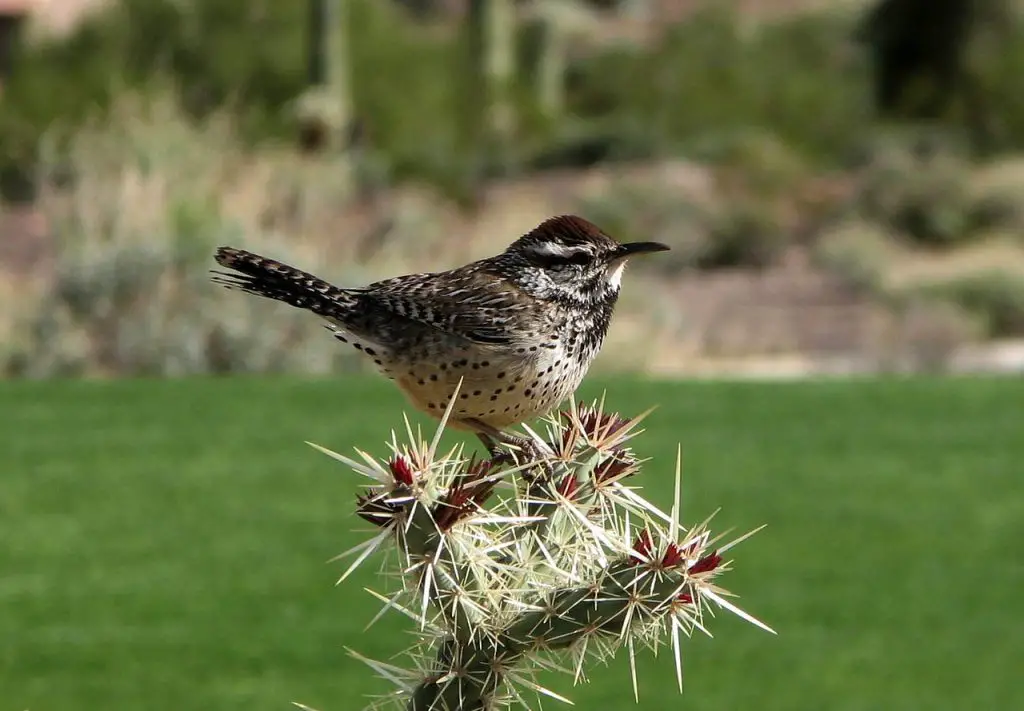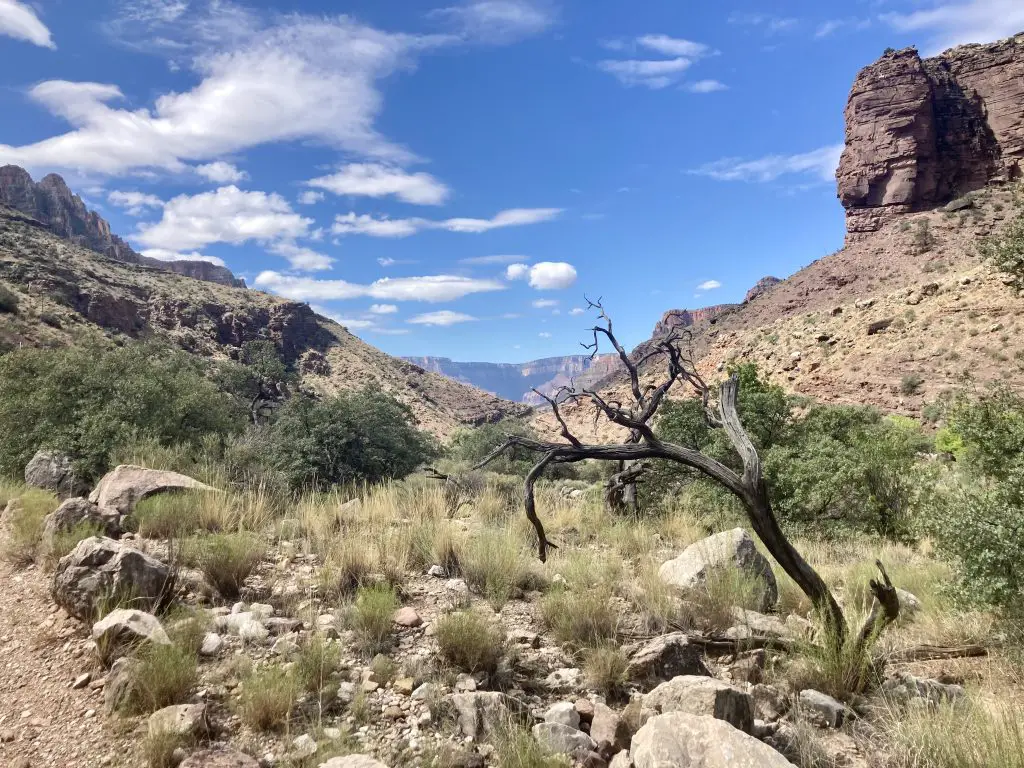The state bird of Arizona is the cactus wren. As a small bird that thrives in the deserts of the Grand Canyon State, it makes sense that the cactus wren took the crown as Arizona’s state bird.
Key Facts:
- The cactus wren is Arizona’s state bird.
- The cactus wren’s scientific name is Campylorhynchus brunneicapillus.
- You can find this beautiful bird throughout the Copper State.
Why is the Cactus Wren Arizona’s State Bird?

When Arizona was selecting a state bird, this desert bird had earned a tough reputation. And since many of the other iconic desert birds were already claimed by neighboring states, Arizona opted to claim the cactus wren as its state bird. This remarkable avian species perfectly embodies the spirit of Arizona’s rugged landscapes and arid deserts.
When Did the Cactus Wren Become Arizona’s State Bird?
Arizona crowned the cactus wren as its state bird in 1931. It’s a beautiful bird that thrives in the arid climate of Arizona. But the bird’s range extends beyond state lines.
Cactus Bird: Physical Features
With its striking white eyeline, bold black streaks, and a distinctive curved bill, the cactus wren effortlessly blends in with the cacti and thorny shrubs that characterize the state’s unique habitat. Their resilient nature and resourceful nesting practices, building nests among thorns for protection, symbolize the resilience and adaptability of Arizona’s wildlife in the face of challenging environments. The Cactus Wren’s harmonious relationship with the arid ecosystem makes it a true emblem of the state’s untamed beauty and a living testament to the wonders of nature found in Arizona’s vast expanse.
Cactus Bird: Habits

The cactus wren is a resourceful bird that is highly territorial. It can be observed defending their preferred cactus or shrub from intruders. In fact, this bird has earned a reputation as being a bully of the desert. With their exceptional climbing abilities and strong bills, they actively forage for insects, spiders, and small fruits among the thorny branches.
In terms of nesting, they construct large, dome-shaped nests made from sticks, grass, and feathers, often placed among the protective spines of cacti to deter predators. These nests can serve as a refuge from the scorching desert heat and offer shelter during cool nights.
The cactus wren is known for its unique vocalizations. According to the Tuscon Audubon Society, they produce a “sputtering, staccato-chugging babble” which can often be heard echoing through the arid landscape. These vocal performances serve multiple purposes, including attracting mates, marking territories, and communicating with other members of their community.
Despite the harsh desert conditions, these resourceful birds have adapted remarkably well to their habitat, showcasing their resilience and versatility. Their habits, uniquely tailored to the challenges of the arid landscape, make the Cactus Wren an emblem of Arizona’s extraordinary wildlife and a true testament to the wonders of nature’s ingenuity.
Cactus Bird: Distribution

The cactus wren’s distribution is primarily centered in the southwestern United States and northern Mexico. Within Arizona, these charismatic birds can be found throughout various regions, ranging from the low desert valleys to the higher elevations of the mountainous terrains.
In the United States, the cactus wren’s range extends beyond Arizona, encompassing parts of California, Nevada, Utah, and New Mexico. The species thrives in arid and semi-arid environments, favoring areas with abundant cacti and shrubs that provide ample opportunities for nesting and foraging.
While the majority of their population resides in the United States, some Cactus Wrens also inhabit northwestern Mexico, particularly in the states of Sonora and Baja California. Their presence in these areas underscores the adaptability of the species to varying desert ecosystems and solidifies their position as a symbol of the enchanting wildlife that graces the arid landscapes of both Arizona and its neighboring areas.
Cactus Bird: Mating
During the breeding season, male Cactus Wrens actively engage in elaborate courtship displays to attract potential mates. They showcase their vibrant plumage and perform impressive aerial acrobatics, singing melodious songs to demonstrate their vitality and fitness.
Once a pair forms a bond, they engage in cooperative nest building. Both the male and female collaborate in constructing their large, dome-shaped nests made of twigs, grass, feathers, and other plant materials. This cooperative nesting behavior strengthens the pair’s bond and enhances their breeding success.
Throughout the breeding season, Cactus Wrens remain highly territorial. They fiercely defend their nesting sites and surrounding areas from intruders, whether they are competing males or potential predators. This territoriality ensures the safety and security of their nesting territory, where they can raise their offspring without disturbances.
As devoted parents, both male and female Cactus Wrens participate in caring for their young. They take turns incubating the eggs and diligently feed and protect their chicks once hatched.
In some seasons, the pair might raise up to three broods. Each clutch usually contains two to seven eggs. The eggs are often salmon pink or beige with reddish spots.
Cactus Bird: Diet
These resourceful birds are primarily insectivores, feeding on a wide range of insects, including grasshoppers, beetles, ants, and caterpillars. Their sharp beaks and agile foraging skills enable them to extract insects from the nooks and crannies of desert vegetation.
Apart from insects, the cactus wren’s diet incorporates various plant-based foods. They consume small fruits, berries, and seeds found amidst the thorny shrubs and cacti that dominate their surroundings. These omnivorous tendencies allow them to adapt their feeding habits to the seasonal availability of resources in the arid landscape.
Additionally, cactus wrens are known to exploit human-provided food sources, such as scraps and crumbs. Their adaptability and willingness to explore new food options further highlight their ability to thrive in the dynamic and challenging environment of the Arizona desert. Through their eclectic diet, these vibrant birds contribute significantly to the balance of their ecosystem and remain a symbol of resilience and survival in the face of harsh conditions.
Arizona’s State Bird: Frequently Asked Questions
You have questions about Arizona’s state bird. I have answers.
What is Arizona’s state flower and bird?
Arizona’s state flower is the Saguaro Cactus Blossom. Arizona’s state bird is the cactus wren.
What is the AZ state animal?
Arizona’s state animal is the ringtail. It’s related to the raccoon. But many call it a ringtail cat.
What eats a cactus wren?
A few animals that eat cactus wrens include hawks, snakes, foxes, bobcats, and coyotes. Additionally, domestic cats can eat these precious birds.
Final Take
The state bird of Arizona is an undeniably beautiful choice. If you are in the Grand Canyon State, consider taking the time to enjoy the sight of the desert birds.
